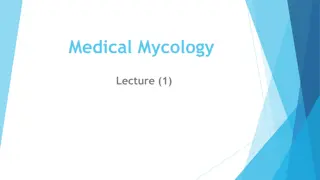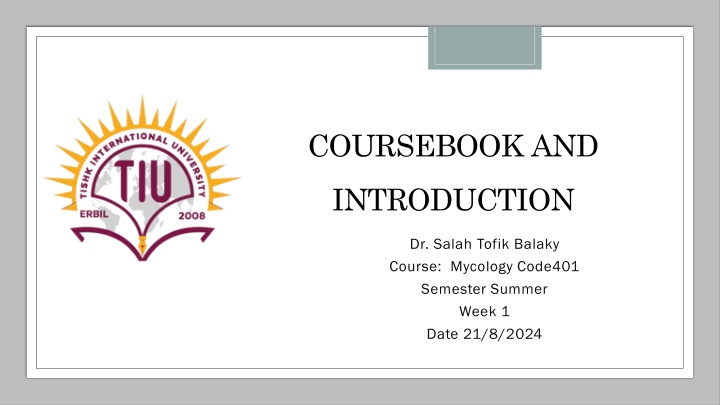
Exploring Mycology: An In-Depth Study of Fungi and Their Importance
Join Dr. Salah Tofik Balaky in a comprehensive course on Mycology, focusing on the biodiversity, evolution patterns, and basic biology of fungi. Explore topics such as fungal characteristics, reproduction, taxonomy, and medicinal uses. The course offers a broad overview of various fungal groups and fungus-like organisms, with examinations and grading components for assessment.
Download Presentation

Please find below an Image/Link to download the presentation.
The content on the website is provided AS IS for your information and personal use only. It may not be sold, licensed, or shared on other websites without obtaining consent from the author. If you encounter any issues during the download, it is possible that the publisher has removed the file from their server.
You are allowed to download the files provided on this website for personal or commercial use, subject to the condition that they are used lawfully. All files are the property of their respective owners.
The content on the website is provided AS IS for your information and personal use only. It may not be sold, licensed, or shared on other websites without obtaining consent from the author.
E N D
Presentation Transcript
COURSEBOOK AND INTRODUCTION Dr. Salah Tofik Balaky Course: Mycology Code401 Semester Summer Week 1 Date 21/8/2024
Course program: Course title: Mycology4th year. Number of credits 2hrs theory and 2hrs practical per week Lecturer: Dr. Salah Tofik Balaky (theory) Course length 15 weeks (course program) Teaching methods (power point presentation)
Course Overview The course provides a general introduction to the study of fungi. The course focuses on understanding biodiversity, patterns of evolution (systematics), and basic biology (such as life cycles and ecosystem function). This course will provide a broad overview of each of the many groups of fungi and some fungus-like organisms.
Module Contents Coursebook and Introduction to Mycology. Definition of mycology, general characteristic of fungi, importance of fungi. Dimorphic fungi, nutrition and metabolism, types of reproduction in fungi. Type of hyphae, type of septum and their functions , structure of fungal cell wall and plasma membrane. Nomenclature of fungi, taxonomy and classification of fungi
Module Contents General characteristics of zygomycota phylum, explanation of some genera. General characteristic of Ascomycota phylum, some species of Ascomycetes. Slime molds and water molds. Fungi as food, medicinal uses of fungi
Student's obligation Attendance on time is an essential requirement for all students. The engagement of every student will be monitored, as Classroom participation is important Mobile phones must be turned off
Examinations The exams will be held during the course. Theoretical and practical exams: one per semester. Final exam Theoretical and practical Exams are composed of SCQ (single choice questions), blanks, true and false, short essays such as definitions and Diagrams
Examinations and Grading: Assessment grading (theory and practical): Exams 30% Quizzes and daily activity 30% Midterm total 60% Final exam: 40%
References Introduction to Fungi By John Webster University of Exeter And Roland Weber University of Kaiserslautern Third Edition. Lansing M. Prescott (2010). Microbiology. Online journal published articles
Mycology Mycology is the branch of Microbiology concerned with the study of fungi, including their genetic and biochemical properties, taxonomy and their use to humans, traditional medicine, food, as well as their dangers, such as toxicity or infection. A Microbiologist specializing in mycology is called a Mycologist.
Next Lecture What are Fungi and their general characteristics

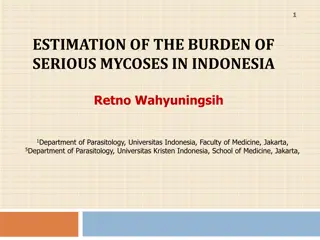


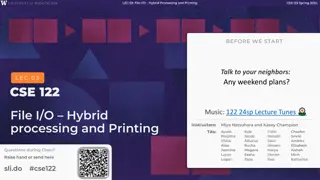
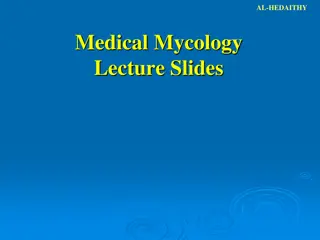
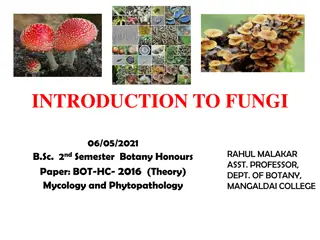
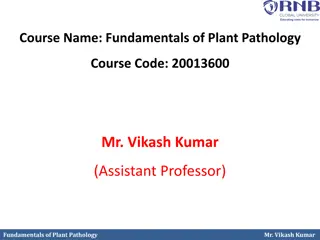
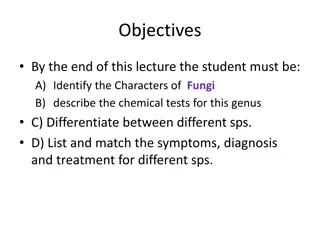
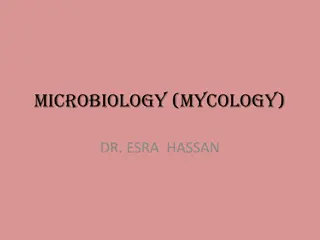
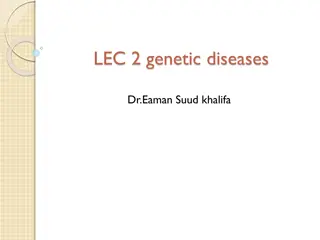
![Lec [2] Health promotion](/thumb/274962/lec-2-health-promotion-powerpoint-ppt-presentation.jpg)

